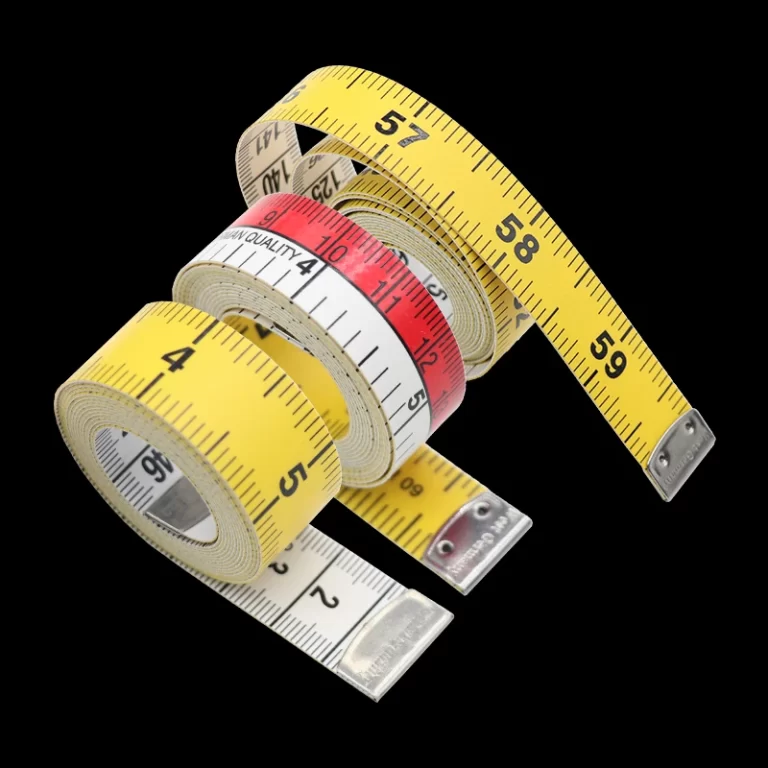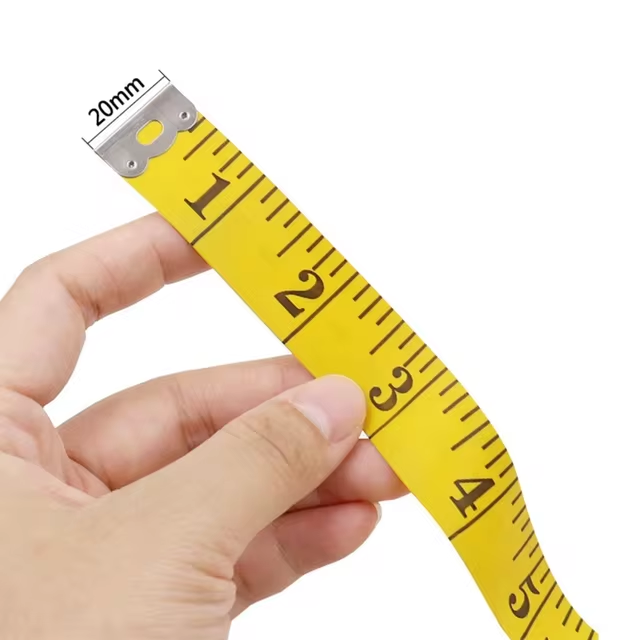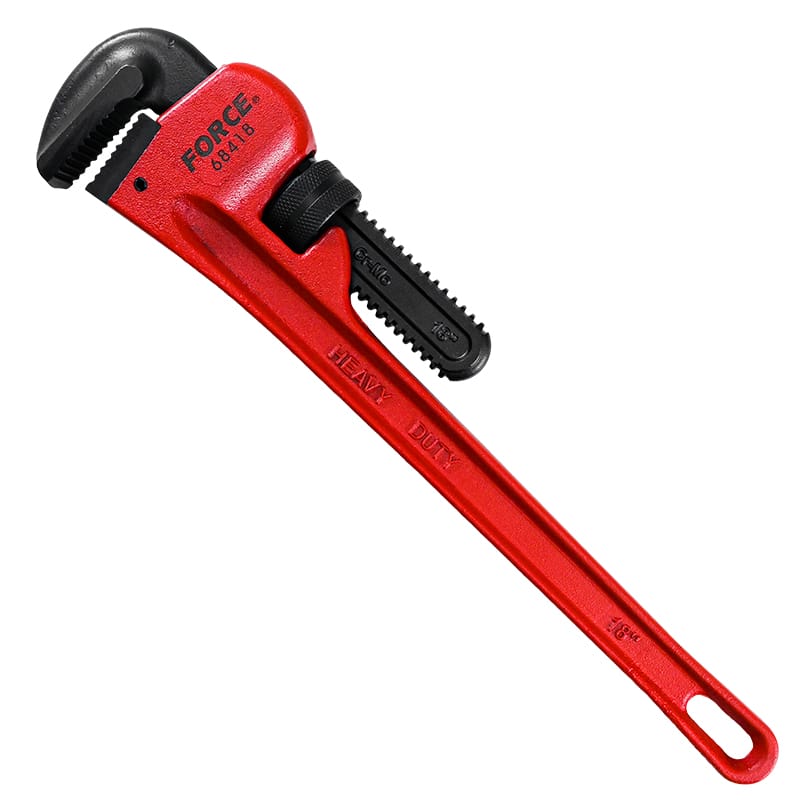
Pipe Wrench : The Right Pipe Wrench for Your Needs
Introduction
Choosing the right pipe wrench is crucial for any plumbing task. This tool is the go-to for professionals and DIY enthusiasts alike when it comes to gripping and turning pipes. It’s important to understand what a pipe wrench is and its role in various tasks.
A pipe wrench is a type of adjustable wrench used for turning soft iron pipes and fittings with a rounded surface. The design of the wrench allows it to grip and apply significant leverage to pipe surfaces, making it indispensable for plumbing repairs and installations. The metal teeth on the wrench’s jaw dig into the pipe’s exterior, which prevents slippage and damage during use.
When you know the basics of a pipe wrench, including its structure and function, you can start to explore the various types, sizes, and materials available. Knowing how to handle a pipe wrench properly can help prevent accidents and ensure a successful outcome for your plumbing project.
In the following sections, we’ll go through different types of pipe wrenches, how to select the perfect size and material, tips for using them safely, maintenance advice, and common applications. We’ll also guide you on selecting the right brand for long-lasting quality. With this knowledge, selecting and using your pipe wrench will be easier and more efficient.
 Types
Types
Choosing the right type of pipe wrench is key to your task. Pipe wrenches come in various styles, each suited for specific jobs. Let’s look at some common types.
Straight Pipe Wrenches
The straight pipe wrench is the most common type. Use it for general plumbing work. It’s great for gripping and turning pipes in open spaces.
End Pipe Wrenches
End pipe wrenches have jaws set at a slight angle. They’re perfect for working in tight spaces or near walls. This design helps grip the pipe at an angle.
Offset Pipe Wrenches
Offset pipe wrenches come with a jaw that’s set off from the handle. They offer better leverage and hand clearance when working on pipes at awkward angles.
Compound Leverage Pipe Wrenches
These wrenches have a special mechanism. It boosts your force when turning stubborn pipes. Their design makes tough loosening tasks easier.
Chain and Strap Wrenches
Chain and strap wrenches lack the traditional metal jaw. Instead, they use a chain or strap to grip the pipe. This design prevents surface damage. They’re great for polished or specialty pipes.
Each type has its own benefits. Make sure to pick the one that fits the job’s needs.
How to Choose the Right Wrench
Choosing the right pipe wrench is about matching the tool to the task at hand. Consider the job you are facing and select a wrench that offers the best fit and leverage. Here are some key factors to keep in mind:
Assess the Job Requirements
First, look at the job. What size are the pipes? Are they exposed or near a wall? These details can influence your decision.
Consider the Wrench Size
A wrench too large or too small can be ineffective or even damaging. Make sure the wrench size complements the pipe’s diameter.
Look at the Wrench Type
Straight, end, offset, compound leverage, chain, or strap? Choose based on the pipe’s location and your clearance for movement.
Think About the Jaw Capacity
The wrench’s jaw capacity must be right for gripping the pipe without slippage. Check this before you begin.
Evaluate the Handle Length
A longer handle can give more leverage but think about the available space. If it’s restricted, a shorter handle might work better.
Acknowledge Your Strength and Experience
A compound leverage wrench can ease a tough job. Know your physical limits and consider a tool that can amplify your strength.
In sum, choosing the right pipe wrench involves assessing the task, knowing your options, and considering the physical space and your own capabilities. With these thoughts in mind, you can pick a pipe wrench that makes your work both safe and efficient.
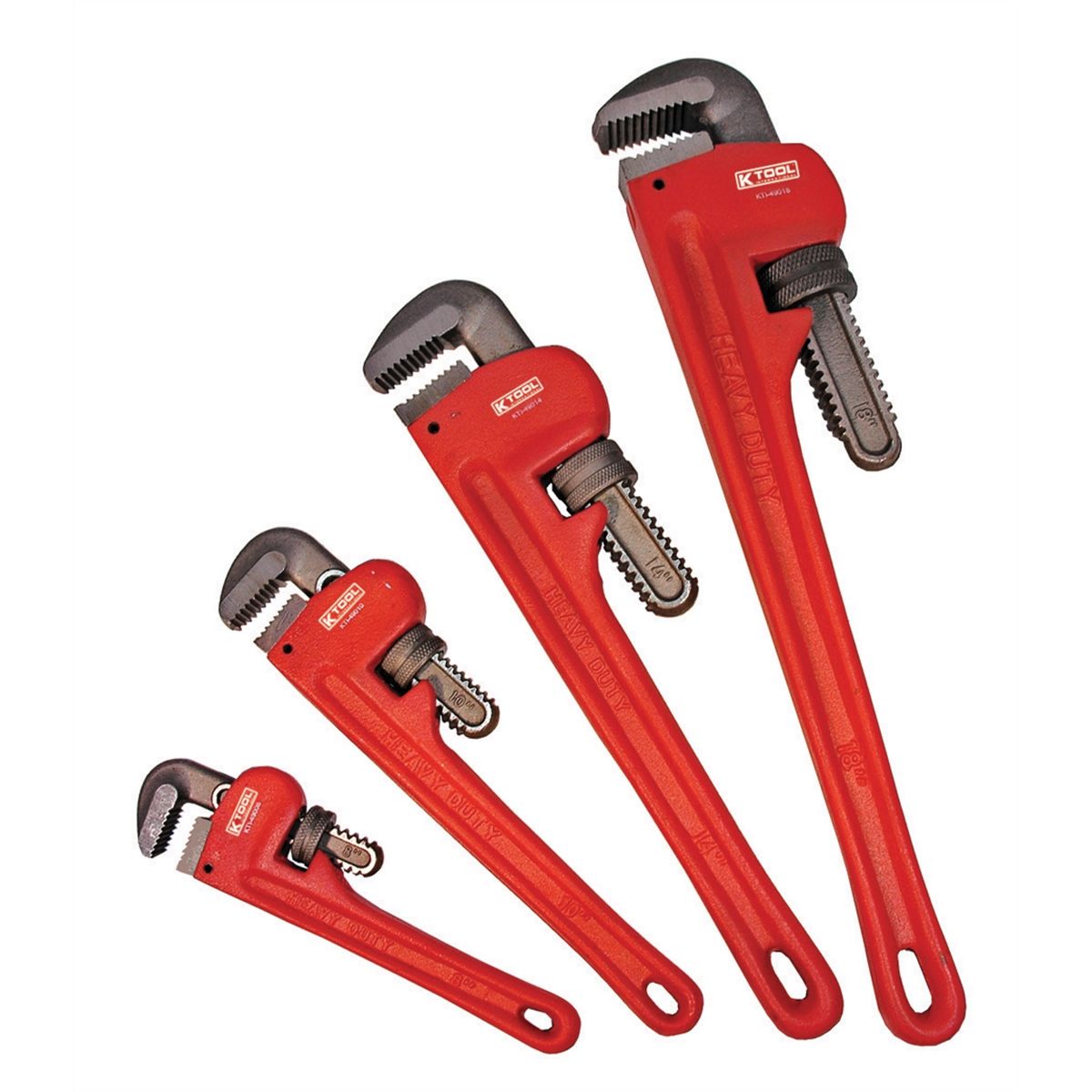 Sizes and Materials
Sizes and Materials
Selecting the appropriate size and material for your pipe wrench enhances its performance and durability. Here’s how to make the best choice.
Choose the Right Size
Pipe wrenches come in a range of sizes. A small wrench may be great for household pipes. A larger one suits industrial tasks better. Always match the tool size to the pipe’s diameter for a snug fit.
Understand the Materials
Wrenches are often made of steel or aluminum. Steel wrenches are strong and heavy, great for tough jobs. Aluminum wrenches are lighter and easier to handle, ideal for long tasks.
Keep in mind that the right size and correct material of your pipe wrench will greatly affect your work’s efficiency and outcome. By considering the type of job and the material of the pipe you’re working on, choosing the most suitable pipe wrench should be straightforward. Ensure that the wrench you select is not only the right size for the job but also made from a material that is appropriate for your needs, whether that be strength, lightweight handling, or a balance of both.
Tips for Using Wrenches Safely and Effectively
To use pipe wrenches safely and get the best results, follow these tips:
Grip the Pipe Correctly
Make sure the wrench’s teeth face the direction you’ll turn the pipe. This gives better grip and power.
Apply Even Pressure
Turn the wrench with steady pressure. Avoid jerking movements to prevent slipping and injury.
Support the Pipe
Hold the pipe firmly with your other hand if possible. This stabilizes it and helps avoid damage.
Avoid Over-Tightening
Stop when the joint is secure. Over-tightening can damage the pipe threads or the wrench itself.
Use the Right Stance
Stand with your feet apart for balance. Position yourself so you don’t fall if the wrench slips.
Inspect the Wrench Before Use
Check for worn teeth and damage. A damaged wrench can slip or break, leading to accidents.
Remember, your safety is as vital as the job itself. Using pipe wrenches correctly prolongs their life and ensures a safer work environment. By sticking to these guidelines, you will handle your pipe wrench with confidence and efficiency.
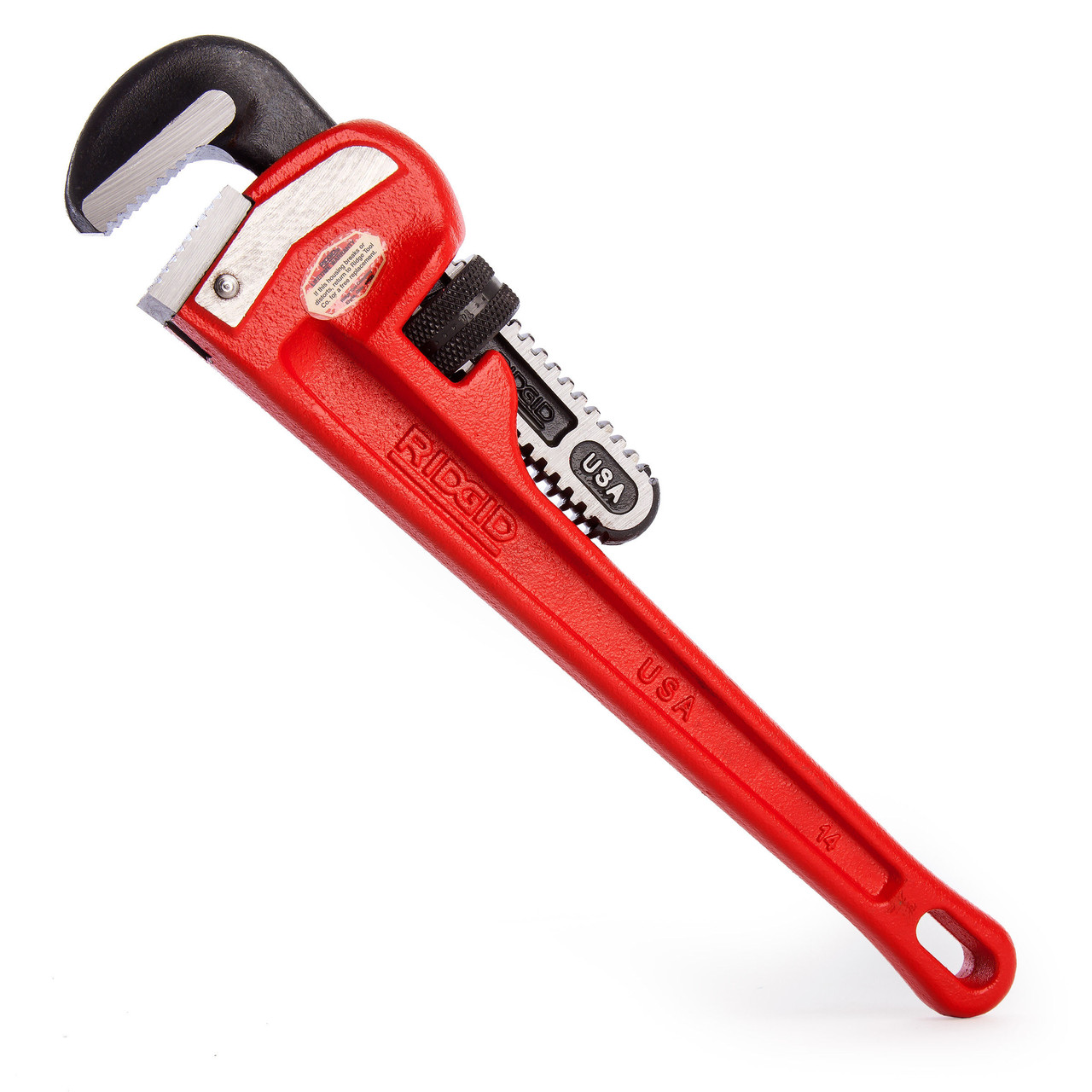 Maintenance and Care
Maintenance and Care
Proper maintenance can extend the life of your pipe wrench. Always keep your wrench clean and dry. Wipe it down after each use to prevent rust. Store it in a cool, dry place to avoid moisture. Check the jaw teeth for wear. If they are dull, replace the jaw or sharpen the teeth. Oil the adjustment mechanism regularly. This keeps it moving smoothly and prevents seizing. Inspect your wrench before use. Look for any cracks or damage that could cause failure. By taking care of your pipe wrench, you ensure its reliability for many jobs to come.
Common Applications
Pipe wrenches are versatile tools in plumbing and beyond. Here’s how they are commonly used:
- For Plumbing Repairs: Pipe wrenches are essential for most plumbing jobs. They tighten and loosen pipes and fittings with ease.
- In Gas Line Installations: Technicians often use pipe wrenches when working with gas lines. They ensure a secure fit to prevent leaks.
- During Construction: Builders may use pipe wrenches to assemble metal frameworks. They need tools that can handle heavy-duty pipes.
- For Oil and Auto Work: These wrenches are also handy in oil fields and auto repair. They grip parts that other tools can’t.
No matter the job, having the right pipe wrench matters. For instance, a straight pipe wrench works well for regular plumbing tasks. But an offset pipe wrench is better for reaching difficult angles. A chain wrench is great for delicate surfaces.
Remember to choose a pipe wrench that matches the task. This ensures a job well done and extends the life of your tools.
Selecting the Right Brand and Quality
When it comes to choosing a pipe wrench, the brand and quality are crucial. Not all wrenches are created equal, and investing in a subpar tool can lead to frustration, work delays, and even injury. Here are key points to remember when selecting the right brand and quality of a pipe wrench:
- Conduct Research: Look for reputable brands with positive reviews. User feedback can guide your selection.
- Check Build Quality: High-quality wrenches often feature precise machining and durable materials. Examine the wrench for solid construction.
- Assess Warranty and Support: Good brands stand behind their products. Look for warranties that offer protection against defects.
- Consider Handle Grip: A comfortable grip reduces hand fatigue. Choose a wrench with a handle designed for comfort.
- Test Adjustability: A smoothly adjusting wrench is easier to use. Make sure the adjustment mechanism operates without sticking.
- Balance Cost and Need: Don’t overpay, but remember that higher quality often comes at a higher price. Find the best balance for your budget and needs.
- Evaluate Texture and Coating: A wrench with good texture on the handle ensures a secure grip. Anti-corrosion coatings protect the wrench from wear.
By taking time to evaluate the brand and quality of a pipe wrench, you can select a tool that offers reliability, durability, and the right features for your specific needs. A well-chosen pipe wrench is an investment that helps ensure safety and efficiency in your projects.
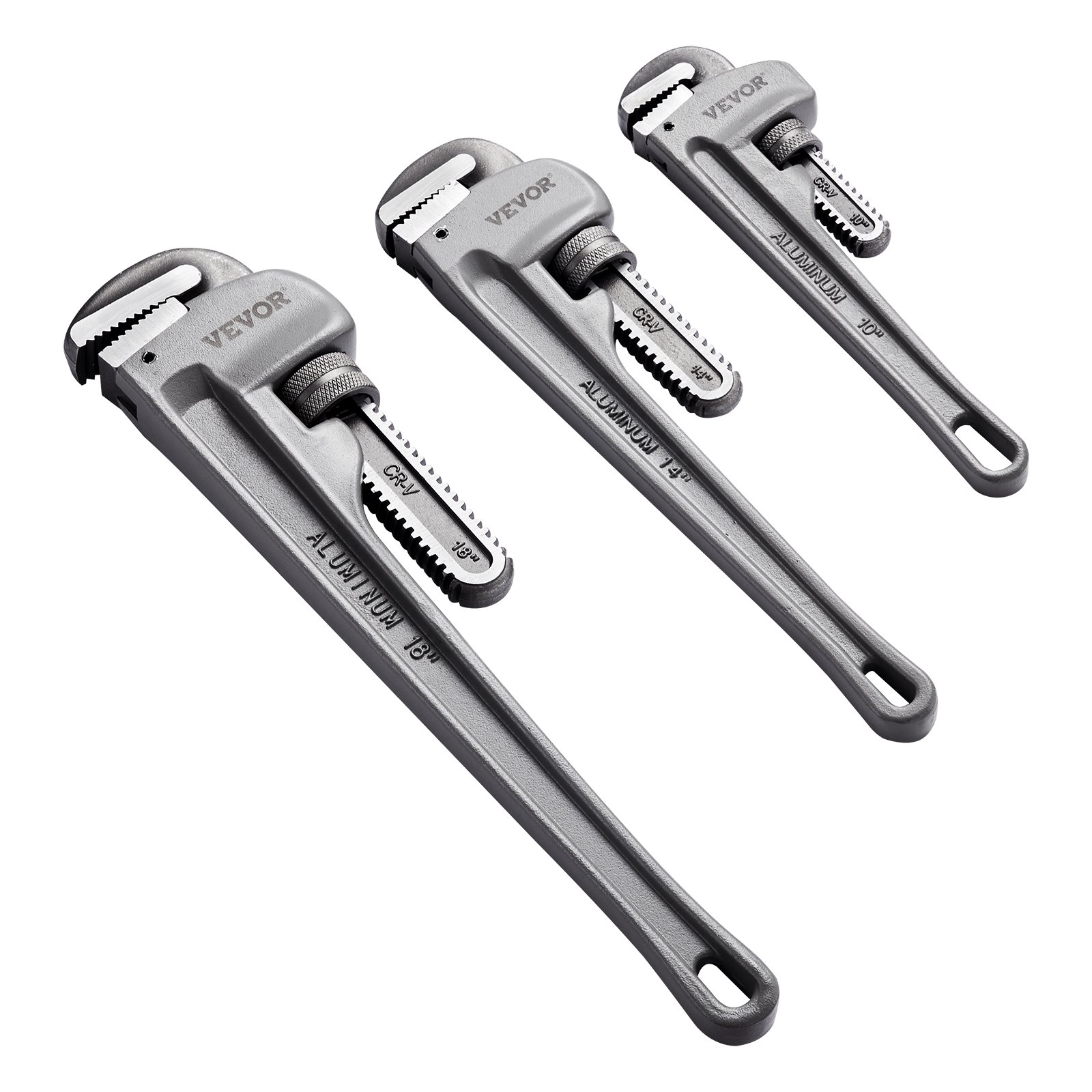 Innovative Uses
Innovative Uses
Plumbing and Pipe Installation
The primary use of a pipe wrench is in plumbing and pipe installation. From tightening fittings to loosening stubborn pipes, the wrench’s ability to grip and turn with precision makes it indispensable in creating secure and leak-free plumbing systems.
Automotive Repairs
In automotive repairs, pipe wrenches can be used to handle various components such as exhaust systems and engine parts. Their strength and adjustability allow for effective manipulation of large bolts and fittings, facilitating smoother repair processes.
Construction and Metalworking
In construction and metalworking, pipe wrenches assist in assembling and disassembling structural components. Their robust design handles heavy-duty tasks, ensuring that pipelines and frameworks are securely fastened and maintained.
DIY Projects and Home Repairs
For DIY enthusiasts, pipe wrenches are versatile tools that can be used in a multitude of home repair projects. Whether you’re fixing a leaking faucet, assembling furniture, or undertaking a renovation, a pipe wrench provides the necessary grip and torque to get the job done efficiently.
Environmental Considerations in Pipe Wrench Production
Sustainable Manufacturing Practices
Many leading pipe wrench manufacturers are adopting sustainable manufacturing practices to minimize their environmental impact. This includes using eco-friendly materials, reducing waste during production, and implementing energy-efficient processes. By choosing pipe wrenches from companies committed to sustainability, you support environmentally responsible manufacturing.
Longevity and Durability
Investing in a high-quality pipe wrench that lasts longer reduces the need for frequent replacements, thereby minimizing environmental waste. Durable tools like those from top brands ensure that your investment serves you well over time, contributing to a more sustainable approach to tool usage.
Recycling and Disposal
When a pipe wrench reaches the end of its lifespan, proper recycling and disposal are essential. Many components of pipe wrenches, such as steel and metal parts, can be recycled, reducing their environmental footprint. Additionally, adhering to local recycling guidelines ensures that discarded tools are handled responsibly.
The Future
Technological Advancements
The future of pipe wrenches is likely to see continued technological advancements aimed at improving functionality and user experience. Innovations such as ergonomic designs, lightweight materials, and enhanced gripping mechanisms will make pipe wrenches even more effective and easier to use.
Smart Tools Integration
Integrating smart technology into pipe wrenches could revolutionize the way we use these tools. Features like torque sensors, digital displays, and connectivity with mobile devices can provide real-time feedback, ensuring precise torque application and reducing the risk of over-tightening or damaging pipes.
Increased Focus on Ergonomics
As awareness of workplace ergonomics grows, pipe wrench designs will increasingly focus on user comfort and reducing strain. Enhanced handle designs, balanced weight distribution, and materials that absorb vibrations will make pipe wrenches more comfortable to use for extended periods, promoting better health and productivity.
 Conclusion
Conclusion
A pipe wrench is more than just a tool; it’s an essential component of any well-equipped toolbox. By understanding the various types, selecting the right size and quality, and mastering effective usage techniques, you can enhance your efficiency and achieve superior results in plumbing, construction, and countless other tasks. Moreover, maintaining your pipe wrench ensures its longevity and reliability, making it a valuable investment for years to come.
As you embark on your projects, remember that the right pipe wrench can make all the difference. Whether you’re a seasoned professional or a DIY enthusiast, investing in a high-quality pipe wrench tailored to your needs will empower you to tackle any challenge with confidence and precision. Embrace the versatility and strength of the pipe wrench, and watch as it becomes an indispensable ally in your toolkit, driving your projects to success with every turn.
